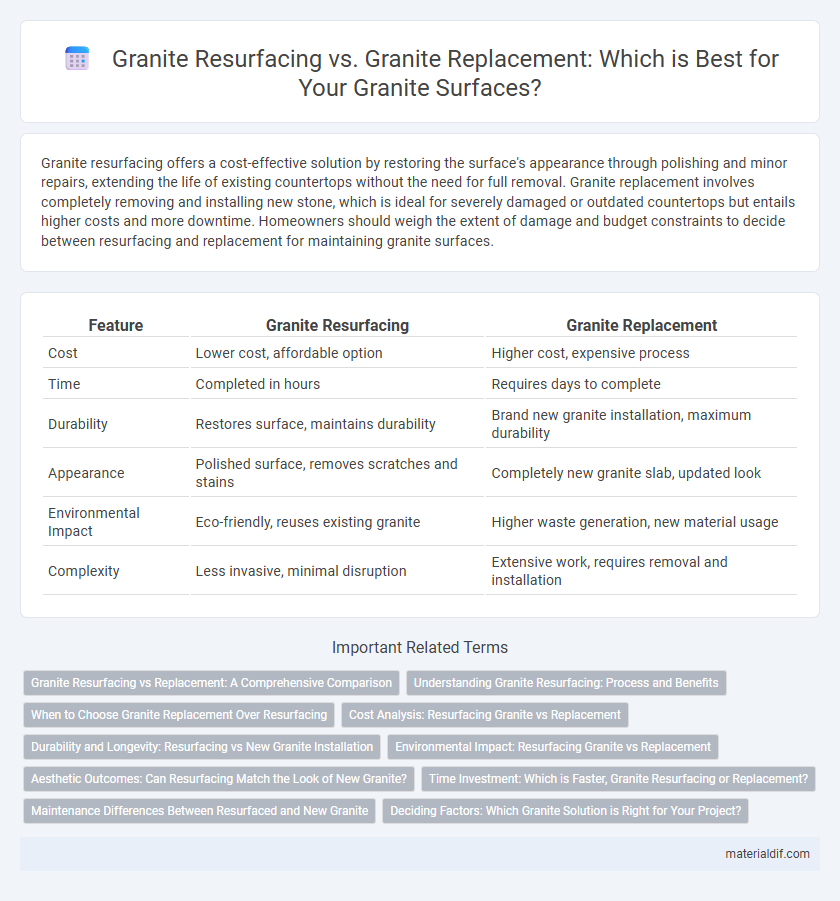Granite resurfacing offers a cost-effective solution by restoring the surface's appearance through polishing and minor repairs, extending the life of existing countertops without the need for full removal. Granite replacement involves completely removing and installing new stone, which is ideal for severely damaged or outdated countertops but entails higher costs and more downtime. Homeowners should weigh the extent of damage and budget constraints to decide between resurfacing and replacement for maintaining granite surfaces.
Table of Comparison
| Feature | Granite Resurfacing | Granite Replacement |
|---|---|---|
| Cost | Lower cost, affordable option | Higher cost, expensive process |
| Time | Completed in hours | Requires days to complete |
| Durability | Restores surface, maintains durability | Brand new granite installation, maximum durability |
| Appearance | Polished surface, removes scratches and stains | Completely new granite slab, updated look |
| Environmental Impact | Eco-friendly, reuses existing granite | Higher waste generation, new material usage |
| Complexity | Less invasive, minimal disruption | Extensive work, requires removal and installation |
Granite Resurfacing vs Replacement: A Comprehensive Comparison
Granite resurfacing offers a cost-effective and environmentally friendly alternative to granite replacement by restoring the stone's surface without the need for full removal and installation. Resurfacing typically involves grinding, polishing, and sealing, which can extend the lifespan of countertops while preserving the natural beauty and durability of granite. In contrast, granite replacement requires extensive labor, higher material costs, and longer project timelines, making resurfacing an attractive choice for homeowners seeking to maintain their granite surfaces efficiently.
Understanding Granite Resurfacing: Process and Benefits
Granite resurfacing involves meticulously grinding and polishing the stone's surface to restore its natural shine and remove scratches, stains, or etching without the need for full replacement. This process preserves the structural integrity of granite countertops while enhancing durability and aesthetic appeal, making it a cost-effective alternative to granite replacement. By choosing resurfacing, homeowners can extend the lifespan of their granite surfaces while maintaining the stone's inherent strength and elegance.
When to Choose Granite Replacement Over Resurfacing
Granite replacement is the optimal choice when countertops have deep cracks, extensive chipping, or irreversible staining that resurfacing cannot fix. Resurfacing suits surfaces with minor scratches or dullness but cannot address structural damage or severe discoloration. Homeowners facing structural integrity issues or outdated aesthetic needs should consider replacement to restore both functionality and appearance.
Cost Analysis: Resurfacing Granite vs Replacement
Granite resurfacing typically costs between $2,000 and $4,500, offering a budget-friendly solution that restores existing surfaces by sanding, polishing, and sealing, whereas granite replacement ranges from $3,000 to $7,000 or more due to material and installation expenses. The price gap depends largely on factors such as countertop size, edge profiles, and labor complexity, making resurfacing a cost-effective option when the granite structure is intact. Resurfacing extends the lifespan by eliminating surface scratches and dullness without the higher investment required for a full granite replacement and remodeling.
Durability and Longevity: Resurfacing vs New Granite Installation
Granite resurfacing restores the surface by removing scratches, stains, and dullness, extending durability without replacing the entire slab, typically lasting 5-10 years depending on use and maintenance. New granite installation offers unmatched longevity, often exceeding 25-30 years, as it eliminates underlying structural issues and provides a completely fresh surface. Choosing between resurfacing and replacement depends on the stone's current condition, with replacement ideal for deep damage or extensive wear impacting the granite's lifespan.
Environmental Impact: Resurfacing Granite vs Replacement
Granite resurfacing significantly reduces environmental impact by minimizing waste and the need for new raw materials compared to granite replacement. Replacement involves quarrying, transporting, and fabricating new granite slabs, contributing to higher carbon emissions and resource depletion. Choosing resurfacing preserves existing granite, promoting sustainability through waste reduction and energy conservation.
Aesthetic Outcomes: Can Resurfacing Match the Look of New Granite?
Granite resurfacing can effectively restore the stone's original luster, fill minor scratches, and remove stains, achieving an appearance nearly identical to new granite at a fraction of the replacement cost. However, resurfacing cannot address significant structural damage or deep chips, which may require full granite replacement to ensure flawless aesthetics. New granite offers complete customization in color and pattern, while resurfacing maintains the existing surface's natural variations, preserving its authentic character.
Time Investment: Which is Faster, Granite Resurfacing or Replacement?
Granite resurfacing typically requires 1-3 days to complete, as it involves polishing, sealing, and minor repairs to restore the existing surface. Granite replacement demands a longer time frame, often 1-2 weeks, due to the removal of old granite, fabrication of new slabs, and installation. Choosing resurfacing significantly reduces downtime, making it a faster option compared to full granite replacement.
Maintenance Differences Between Resurfaced and New Granite
Resurfaced granite requires less intensive maintenance compared to new granite, as the process seals minor scratches and imperfections, reducing the need for frequent sealing and polishing. New granite, while initially guaranteed to have no flaws, demands regular sealing to protect its natural porosity and prevent staining or etching. Over time, resurfaced granite may need periodic touch-ups to restore its finish, whereas new granite typically maintains its durability longer under standard care routines.
Deciding Factors: Which Granite Solution is Right for Your Project?
Granite resurfacing is a cost-effective option when dealing with minor scratches, stains, or dullness, preserving the existing slab and maintaining structural integrity. Granite replacement becomes necessary for severe damage such as deep cracks, extensive chipping, or outdated designs requiring a complete aesthetic overhaul. Key deciding factors include budget constraints, extent of damage, desired outcome, and long-term durability preferences.
Granite Resurfacing vs Granite Replacement Infographic

 materialdif.com
materialdif.com